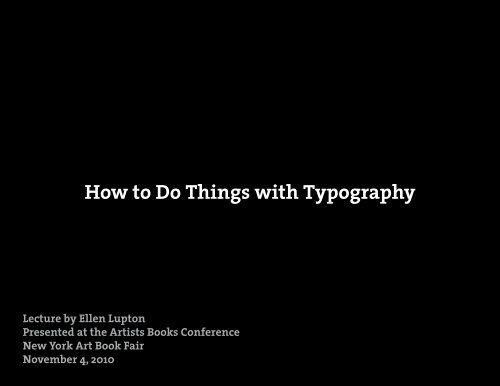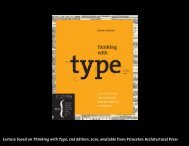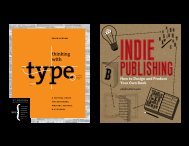Artists Books: How to Do Things with Typography - Thinking with Type
Artists Books: How to Do Things with Typography - Thinking with Type
Artists Books: How to Do Things with Typography - Thinking with Type
- No tags were found...
Create successful ePaper yourself
Turn your PDF publications into a flip-book with our unique Google optimized e-Paper software.
<strong>How</strong> <strong>to</strong> <strong>Do</strong> <strong>Things</strong> <strong>with</strong> <strong>Typography</strong>Lecture by Ellen Lup<strong>to</strong>nPresented at the <strong>Artists</strong> <strong>Books</strong> ConferenceNew York Art Book FairNovember 4, 2010
theorytypehowwhypracticeellen lup<strong>to</strong>nthinking<strong>with</strong>entertainingeconomicalessentialINDIEPUBLISHING<strong>How</strong> <strong>to</strong> Design and ProduceYour Own Bookedited by Ellen Lup<strong>to</strong>n2 ND EDITIONREVISED & EXPANDEDMOREprinciplesexamplesexercisestype crimesfontsfac<strong>to</strong>ids {funa critical guidefor designers,writers, edi<strong>to</strong>rs,& students
ellen lup<strong>to</strong>ntypehowwhypracticethinking<strong>with</strong>entertainingeconomicalessentialINDIEPUBLISHIN<strong>How</strong> <strong>to</strong> Design and ProducYour Own Bookedited by Ellen Lup<strong>to</strong>nNDEDiplesplesisesrimesa critical guidefor designers,writers, edi<strong>to</strong>rs,& studentsids
The book has becomea site of frenzied activity.Red76, Booth J15, The New York Art Book Fair, 2010
Published 1962
The uttering of the sentenceis the doing of an action.
<strong>to</strong> swear<strong>to</strong> promise<strong>to</strong> vow<strong>to</strong> name<strong>to</strong> bet
The circumstances in which the words are utteredshould be in some way appropriate.It is commonly necessary that either the speakeror other persons should also perform certain otheractions, whether physical or mental or even acts ofuttering further words.
(<strong>How</strong> <strong>to</strong> <strong>Do</strong> <strong>Things</strong> <strong>with</strong> <strong>Typography</strong>)
F.R.David, “Idi<strong>to</strong>rial’ issue. de Appel, 2009. Edi<strong>to</strong>r: Will Holder <strong>with</strong> Ann Demeester andDieter Roelstraete. Design: Will Holder. Text: Dieter Roelstraete.
Writing informs and feeds, supports anddescribes, backs up and interprets, comments andreflects upon contemporary artistic production.
<strong>Typography</strong>:the arrangement of textin space and time.
<strong>Typography</strong>is what language looks like.
Letter from Muriel Cooper<strong>to</strong> PLAN Magazine, 1980.Reproduced by DavidReinfurt in <strong>Do</strong>t <strong>Do</strong>t <strong>Do</strong>t 15,2007.
Working Library website, written, edited, and designed by Mandy Brown (2010).
(front cover)(back cover)Liner Notes: Conversations About Making <strong>Books</strong>. Edited by Markus Dressen, Lina Grumm, Anne König,and Jan Wenzel. Spec<strong>to</strong>r <strong>Books</strong>, 2010. Distributed by Mot<strong>to</strong>.
“What does it mean <strong>to</strong> design a book? As designproduces an independent text, the designer’srole could be compared <strong>to</strong> that of an author.As design marks a position regarding thecontent, the designer’s frame of action could becompared <strong>to</strong> that of a critic.”
Three developments in the life of the book:
Three developments in the life of the book:The resurgence of writing
Three developments in the life of the book:The resurgence of writingBook as social media
Three developments in the life of the book:The resurgence of writingThe book as social mediaThe diffusion of the author
The death of the authorThe birth of the reader“A text is made of multiple writings...The reader is the space on which all thequotations that make up a writing areinscribed; a text’s unity lies not in itsorigins but in its destination.”—Roland Barthes
Bernadette Corporation. Reena Spaulings. Semiotext(e), 2004.
“An author is a routine, which makesfor good conversation wheneverthat routine climbs down from thewindswept seclusion that walks andbreathes centuries of the word.”
A Wikipedia Reader1 Paul Branca2 Dexter Sinister3 Barbara Ess4 Fillip5 Rob Giampietro6 Marc Handelman7 Zach Hous<strong>to</strong>n8 Adam Katz and Julia Sherman9 Brian Kennon/2nd Cannons Publications10 Chosil Kil11 Alex Klein12 Marisa Olson13 Paul Pieroni14 Laurel Ptak15 Eileen Quinlan16 Michael Smoler17 Jamie Stewart18 Oraib Toukan19 Lia Trinka-Browner20 Jen Delos Reyes21 Rafael Rozendaal22 Ryan Waller23 Amy YaoWhat follows is the documentation of23 travels <strong>with</strong>in Wikipedia (navigatingfrom article <strong>to</strong> article viaa connecting hyper-link, producinga string of connecting articles).The string of articles produced byeach travel can be unders<strong>to</strong>od asa kind of mental-map: a wanderingin thought, or a deeper continuousinvestigation. The decisions thateach contribu<strong>to</strong>r made will hopefullyproduce not only an arrayof interesting subjects, but alsoserve as a kind of supplementalreader <strong>to</strong> their own creativepractice. Presenting these linkssequentially as they were traveledis also a kind of orderingmethod. To an extent, digital systemsmake hierarchical categorizingand analog ordering irrelevant (seeintroduction <strong>to</strong> A Wikipedia Reader,2008). Information online is notnecessarily categorized and orderedin the traditional sense, it isinterconnected <strong>with</strong> everything, andaccessed through these connections.Here the contribu<strong>to</strong>rs themselvesbecome the categories through theirown choices of what connection <strong>to</strong>follow. The articles are abridgedbecause of printing limitations. Itmust also be unders<strong>to</strong>od that eachprinted article is also a documentationin the article’s continuouslygrowing life. That is the nature ofuser-generated content. <strong>Things</strong> arerevised and updated. Some of theconnections presented here may nowbe broken. Like old trolley lines,they belong <strong>to</strong> a different time.Yet unlike these old lines, theycan be reconnected. Obviously, thenature of Web 2.0 opens up room forfactual error. It also opens uproom for tinkering and play, whichwas not present in the first reader.Oraib Toukan’s travel includes afictitious article in between factualones (this article lasted nolonger than a day). It is a cultureof participation. Even trickstersand trouble-makers can participate.But this tinkering is not alwaysrooted in misinformation. Whenlooking at the Hannah Arendt article(which came up twice throughMarc Handelman and Eileen Quinlan),I had the uncanny realization thatI was looking at my own hand inthe pho<strong>to</strong>graph of her graves<strong>to</strong>ne.I uploaded the pho<strong>to</strong>graph over ayear before and had forgotten aboutit. I had thought, <strong>with</strong> it becomingmore difficult <strong>to</strong> play <strong>with</strong> thetext, why not play <strong>with</strong> the images?Anyone can assert their presencein the backgrounds and margins ofpho<strong>to</strong>graphs, becoming part of theinformation.David Horvitz, September 2009This was commissioned by the Art Libraries Societyof New York for the Contemporary <strong>Artists</strong> <strong>Books</strong>Conference at Printed Matter’s 2009 NY Art BookFair. It was organized through David Senior at theMuseum of Modern Art Library.1985Acadian DriftwoodAdaptationAdrenal MedullaAfterimagesAhimsaAl-HurriyaAldous HuxleyAlzheimer’s diseaseAnalog HoleAndrew HuxleyAnimismAsparagusAssholeAttentionAttention-DeficitHyperactivity DisorderAugmented RealityAugmented VirtualityAu<strong>to</strong>biography of MalcolmXAxonAyurvedicBBCBabiesBanality of EvilBard CollegeBellevue Hospital CenterThe Birth of Tragedy fromthe Spirit of MusicBlack and White DualismBob DylanBot<strong>to</strong>m of the PyramidBoulderBoy SopranoBrewer’s Dictionary ofPhrase and FableBroadmoor HospitalBrothelsCentral IntelligenceAgencyCharles Sanders PeirceChoirCobbleCocktail Party EffectThe Colbert ReportCommodore 64Constructed LanguageCopy ProtectionCrossbowCyberpunkData-miningDaydreamDealerDepersonalizationDharmacakraDiane VreelandDistributionDreamDualismDylan ThomasEgo DeathEnclave and ExclaveEuropean MicrostatesEvangelineEwald HeringExtraterri<strong>to</strong>rialityEye MovementFaces of DeathFergieFlowersFord Model TFordlandiaFormal LanguageFriedrich NietzscheGödel’s IncompletenessTheoremsGeopoliticsGhassan KanafaniGhost in the MachineGoguryeoThe GoodiesGrapeGravelGreat UpheavalGreg DykeHallucinogen-Persisting-Perception DisorderHannah ArendtHarper’s BazaarHealth CareHenry WadsworthLongfellowHillHizbelHurHorizontal Gene TransferHuman AnimalCommunicationHuman SpeechomeProjectHunter vs. Farmer TheoryHyperfocusI’m Sorry, I’ll Read ThatAgainI’m Sorry I Haven’t aClueIllegal Drug TradeIllnessInfinite SetInfinityInterspeciesCommunicationIslamic calligraphyJabberwockyJames JoyceJapanJune and Jennifer GibbonsKara WalkerKiberaKilroy Was HereKoreaLSDLibya National FootballTeamLiechtensteinLightList of deitiesThe Magical NumberSeven, Plus or Minus TwoMantraMarcel DuchampMary’s RoomMaterialismMeditationMenachem BeginMichel FoucaultMixed RealityMnemonicMobile PhoneMountainMushroomMushroom CloudMyceliumMythologyNaive Set TheoryNaji al-AliNames of GodNauseaNeologismNeuralgiaNeuroscienceNonce WordNonviolentNuclear WeaponsObjects of the MindOmnidirectional TreadmillOptical IllusionOrganumOrigin of languageOur Band Could Be YourLifeOxford English DictionaryPainPeanutsPebblePeppermintPolice Enforced ANPR inthe UKPolyphonyPopulation BottleneckPortmanteauxPostmaterialismPragmatismPrecisionismPrincipia MathematicaProhibition in the UnitedStatesQalamQualiaQuarkRapid Eye MovementRasul v. BushRecord LabelReproductionRhizomeRockRoland RatRoman NumeralsRussian RouletteSR-71 BlackbirdSan FranciscoSanskritSantiago Ramon Y CajalSarah McLachlanSatireSetShamanismSheila E.Shock ArtSilent LetterSimulated RealitySing-alongSleep DeprivationSnowcloneSoaplandSongs of MassDestructionSoulStanford PrisonExperimentStill LifeStimulationS<strong>to</strong>kely CarmichaelStressSubitizing and CountingSummitSuperior ColliculusSystemic BiasTalking AnimalTally SticksTandemTandem BicycleTaxus BaccataTelevisionTetragramma<strong>to</strong>nThomas NagelTitaniumTranshumanismTurkish BathUnderground EconomyUnisonVaccinationVegetarianismVideotapeVile BodiesVirtual RealityVoluntary HumanExtinction MovementWaxwingWe Are the WorldWestern EuropeWikipediaWilliam JamesA Wikipedia Reader. Commissioned by the Art Libraries Society of New York for the Contemporary<strong>Artists</strong> <strong>Books</strong> Conference at Printed Matter’s 2009 NY Art Book Fair.
Dexter SinisterPragmatism William James Charles Sanders Peirce Principia Mathematica2PragmatismPragmatism is the philosophywhere practical consequencesand real effects are vitalcomponents of meaning andtruth. Pragmatism began in thelate nineteenth century <strong>with</strong>Charles Sanders Peirce andhis pragmatic maxim. Throughthe early twentieth-centuryit was developed further inthe works of William James,John Dewey and—in a moreunorthodox manner—by GeorgeSantayana. Other importantaspects of pragmatisminclude anti-Cartesianism,radical empiricism, instrumentalism,anti-realism,verificationism, conceptualrelativity, a denial of thefact-value distinction, ahigh regard for science, andfallibilism.Pragmatism enjoyed renewedattention from the1960s on when a new analyticschool of philosophy(W. V. O. Quine and WilfridSellars) put forth a revisedpragmatism criticizing thelogical positivism dominantin the United States andBritain since the 1930s.Richard Rorty further developedand widely publicizedthe concept of naturalizedepistemology; his later workgrew closer <strong>to</strong> continentalphilosophy and is consideredrelativistic by itscritics.Contemporary pragmatismis divided in<strong>to</strong> a strictanalytic tradition, a morerelativistic strand (in thewake of Rorty), and “neoclassical”pragmatism (suchas Susan Haack) that adheres<strong>to</strong> the work of Peirce, James,and Dewey.OriginsPragmatism as a philosophicalmovement began in theUnited States in the late1800s. Its overall directionwas determined by thethought and works of Charlesidealism by providing an“ecological” account ofknowledge: inquiry is howorganisms can get a grip ontheir environment. Real andtrue are functional labelsin inquiry and cannot beunders<strong>to</strong>od outside of thiscontext. It is not realistin a traditionally robustsense of realism (whatHilary Putnam would latercall metaphysical realism),but it is realist in howit acknowledges an externalworld which must be dealt<strong>with</strong>.With the tendency ofphilosophers <strong>to</strong> group allviews as either idealisticor realistic, (along <strong>with</strong>William James’ occasionalpenchant for eloquence atthe expense of public understanding),pragmatism wasseen as a form of subjectivismor idealism. Many ofJames’ best-turned phrases—truth’s cash value and thetrue is only the expedientin our way of thinking — weretaken out of context andcaricatured in contemporaryliterature as representingthe view where any idea <strong>with</strong>practical utility is true.In reality, James asserts,the theory is a greatdeal more subtle.The role of belief in representingreality is widelydebated in pragmatism. Is abelief valid when it representsreality? Copying isone (and only one) genuinemode of knowing. Are beliefsdispositions which qualifyas true or false dependingon how helpful they provein inquiry and in action? Isit only in the struggle ofintelligent organisms <strong>with</strong>the surrounding environmentthat beliefs acquire meaning?<strong>Do</strong>es a belief only becometrue when it succeeds inthis struggle? In Pragmatismnothing practical or usefulis held <strong>to</strong> be necessarily<strong>to</strong> his<strong>to</strong>rians, biographers,and critics.James interacted <strong>with</strong> awide array of writers andscholars throughout hislife, including his godfatherRalph Waldo Emerson,his godson William JamesSidis, as well as BertrandRussell, Horace Greeley,William Cullen Bryant, OliverWendell Holmes, Jr., CharlesPeirce, Josiah Royce, GeorgeSantayana, Ernst Mach, JohnDewey, Walter Lippmann, W.E. B. Du Bois, Helen Keller,Mark Twain, Horatio Alger,Jr., James George Frazer,Henri Bergson, H. G. Wells,G. K. Chester<strong>to</strong>n, SigmundFreud, Gertrude Stein, andCarl Jung.EpistemologyJames defined true beliefsas those that prove useful<strong>to</strong> the believer. His pragmatictheory of truth was asynthesis of correspondencetheory of truth and coherencetheory of truth, <strong>with</strong>an added dimension. Truth isverifiable <strong>to</strong> the extent thatthoughts and statements correspond<strong>with</strong> actual things,as well as the extent <strong>to</strong>which they “hang <strong>to</strong>gether,”or cohere, as pieces of apuzzle might fit <strong>to</strong>gether;these are in turn verified bythe observed results of theapplication of an idea <strong>to</strong>actual practice.“The most ancient partsof truth . . . also oncewere plastic. They also werecalled true for human reasons.They also mediatedbetween still earlier truthsand what in those days werenovel observations. Purelyobjective truth, truth inwhose establishment thefunction of giving humansatisfaction in marryingprevious parts of experience<strong>with</strong> newer parts played norole whatsoever, is nowhere<strong>to</strong> be found. The reasons whyfacts again and add <strong>to</strong> them;which facts again create orreveal new truth (the wordis indifferent) and so onindefinitely. The ‘facts’themselves meanwhile arenot true. They simply are.Truth is the function of thebeliefs that start and terminateamong them.” RichardRorty claims that James didnot mean <strong>to</strong> give a theoryof truth <strong>with</strong> this statementand that we should not regardit as such. <strong>How</strong>ever, otherpragmatism scholars suchas Susan Haack and <strong>How</strong>ardMounce do not share Rorty’sinstrumentalist interpretationof James.In The Meaning of Truth,James seems <strong>to</strong> speaks oftruth in relativistic terms:“The critic’s [sc., the critic ofpragmatism] trouble...seems <strong>to</strong>come from his taking the word‘true’ irrelatively, whereas thepragmatist always means ‘truefor him who experiences theworkings.’”<strong>How</strong>ever, James responded <strong>to</strong>critics accusing him of relativism,scepticism oragnosticism, and of believingonly in relative truths.To the contrary, he supportedan epistemologicalrealism position.Peirce, but Peirce’s workwas not widely known untilafter this was written.) A.N. Whitehead, while readingsome of Peirce’s unpublishedmanuscripts soonafter arriving at Harvardin 1924, was struck by howPeirce had anticipated hisown “process” thinking.Karl Popper viewed Peirce as“one of the greatest philosophersof all times”.Nevertheless, Peirce’saccomplishments were notimmediately recognized. Hisimposing contemporariesWilliam James and JosiahRoyce admired him, andCassius Jackson Keyser atColumbia and C. K. Ogdenwrote about Peirce <strong>with</strong>respect, but <strong>to</strong> no immediateeffect.The first scholar <strong>to</strong> givePeirce his considered professionalattention wasRoyce’s student MorrisRaphael Cohen, the edi<strong>to</strong>rof a 1923 anthology ofPeirce’s writings titledChance, Love, and Logicand the author of the firstbibliography of Peirce’sscattered writings. Johnimpact of Peirce’s thoughtthrough 1983.Peirce has come <strong>to</strong> enjoya significant internationalfollowing. There are universityresearch centers devoted<strong>to</strong> Peirce studies and pragmatismin Brazil, Finland,Germany, France, Spain, andItaly. His writings havebeen translated in<strong>to</strong> severallanguages, including German,French, Finnish, Spanish,and Swedish. Since 1950,there have been French,Italian, Spanish and BritishPeirceans of note. For manyyears, the North Americanphilosophy department mostdevoted <strong>to</strong> Peirce was theUniversity of Toron<strong>to</strong>’s,thanks in good part <strong>to</strong> theleadership of Thomas Goudgeand David Savan. In recentyears, American Peircescholars have clustered atIndiana University - PurdueUniversity Indianapolis, thehome of the Peirce EditionProject, and the PennsylvaniaState University.Principia MathematicaThe Principia Mathematicais a 3-volume work on the
Au<strong>to</strong> Blogging: Writing <strong>with</strong>out Writers
content farmingspamdexingau<strong>to</strong> bloggingWriting <strong>with</strong>out Writersau<strong>to</strong>matic content genera<strong>to</strong>rscloakingarticle spinning
Combat <strong>Typography</strong>:<strong>How</strong> <strong>to</strong> disrupt the text
Rick Poynor, 1991
Jonathan Barnbrook and Rick Poynor, 1996.
Metahaven. Uncorporate Identity. Lars Muller Publishers, 2010.
Normative <strong>Typography</strong>:<strong>How</strong> <strong>to</strong> polish the veneerof respectability
David Barringer. American Home Life. So New Publishing, 2007.
Meta <strong>Typography</strong>:<strong>How</strong> <strong>to</strong> play <strong>with</strong> yourapparatus
On the Self-Reflexive Page. Edited, written, and designed by Louis Lüthi. Roma, 2010. Cover: fromLaurence Sterne, The Life and Opinions of Tristram Shandy, Gentleman, first published 1759; OxfordUniversity Press edition, 1983.
Laurence Sterne, The Life and Opinions of Tristram Shandy, Gentleman, first published 1759;Oxford University Press edition, 1983. Reproduced in Lüthi, On the Self-Reflexive Page.
“When it comes <strong>to</strong> visual elements…contemporary critics have onthe whole been guarded, if notdisdainful….”
Jonathan Safran Foer, Extremely Loud and Incredibly Close. Penguin, 2006.Reproduced in Lüthi, On the Self-Reflexive Page.
Dieter Rot, “Hansel und Gretel,” Gessamelte Werke. Editions Hanjörg Mayer, 1971.Reproduced in Lüthi, On the Self-Reflexive Page.
Carl Frederick Reuterswärd. Prix Nobel. Bonniers, 1960.Reproduced in Lüthi, On the Self-Reflexive Page.
Leanne Shap<strong>to</strong>n. Important Artifacts and Personal Property... 2009
Zombie <strong>Typography</strong>:<strong>How</strong> <strong>to</strong> raise the dead
“It is a truth universallyacknowledged, that a single manin possession of a good fortunemust be in want of a wife.”jane austen, Pride and Prejudice
Jane Austen and Seth Grahame-Smith, Pride and Prejudice and Zombies.Published by Quirk <strong>Books</strong>, 2009. Cover design: <strong>Do</strong>ogie Horner.
Will Holder. “The Middle of Nowhere.” <strong>Do</strong>t <strong>Do</strong>t <strong>Do</strong>t Fifteen, 2007.Based on William Morris’s News from Nowhere.
From William Morris’sNews from Nowhere.
Found <strong>Typography</strong>:<strong>How</strong> <strong>to</strong> wear second-hand prose
Founding artifact of Found Magazine, founded by Davy Rothbart.
Graham Rawle. Woman’s World, 2007.
Material <strong>Typography</strong>:<strong>How</strong> <strong>to</strong> do things
Ruud Linssen. Book of War, Mortification, and Love. Underware, 2010. Set in Fakir.





